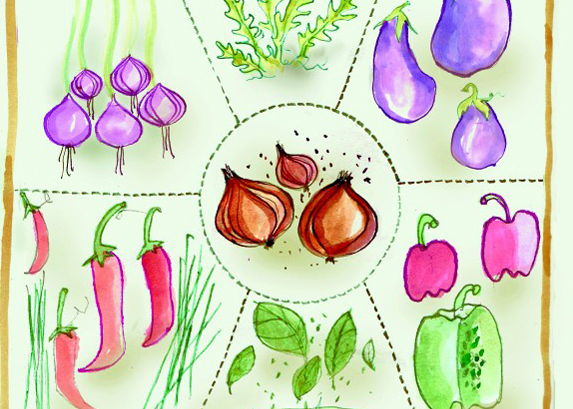Many of us put off trying to grow our own food because we don’t think we have the time. But here’s a garden that even the ultra-busy can maintain.
Many of us put off trying to grow our own food because we don’t think we have the time. We look from our own gardens to magazine pictures of gardens covered from fence to fence with productive beds and throw up our hands. It’s not so hard, says Lolo Houbein, author of the inspirational new book One Magic Square
Small is truly beautiful. No matter how overgrown your garden, you can weed one square metre, plant it and keep it tidy. It may lead on to two square metres or even a block of four – that’s up to you. Be kind to yourself. Start with one magic square for the plot of your choice.
Your problem is that you don’t have time. You’re overworked and a little stressed. You don’t get much opportunity to relax. You worry about the bills or the amount of fast food you, or your family, consumes. You may be depressed and unable to appreciate the good things in life. You’re always busy and you don’t get enough exercise. If any one of these conditions depicts your life, change it instantly by digging up one square metre. It won’t take much time or work, as it is only 100cm by 100cm, one stride by one stride. But it will relax and delight you. In a short time it will provide you with fresh food. Your depressive moods will evaporate when you tend your magic square. Boredom will fade away and you’ll do a daily three-minute bending-and-stretching routine without being aware of it. Hand-watering the square will become your meditation.
Where to find these minutes? So many books on growing vegetables show photographs of neat, weed-free rows with not a shrivelled leaf in sight. These are ready-made free dinners for hordes of insects. Control your urban yearning for straight rows. Grow vegetable varieties interspersed with companion plants, selfseeding herbs and marigolds—the insect hordes will fly over and there’ll be no space for weeds.
You’ll be surprised how far you can get with a few broccoli, kale, come-again lettuce plants and Asian greens—there are months of picking there. Grow carrots closely and pull as needed, making space for the remainder. Plant silverbeet in a dense drift and pick it tender for several seasons. One square of sweet corn can yield 50 cobs, or 20 fresh broad bean portions and another 20 for the freezer. Potatoes, beetroot, swedes, tomatoes, beans, cucumbers and antioxidant greens are all high yielders in small spaces.
Less time spent shopping for vegetables means time to tie up the beans and plug in a few seeds. Bend, reach, turn, stretch and take deep breaths of fresh air, so you don’t need to go to the gym, saving time and money. Move beyond one square and you won’t need to go jogging either.
More time can be found by working the way that suits you best. Pick over a quarter of your plot, plant seedlings, sow seeds, water them and call it a day, satisfied. Another day remove spent plants from a productive corner and manure and water it, ready for replanting.
Work in time increments. Ten minutes of mulching. Don’t cry: “Oh Mother of Cabbages, I have no time for all that today!” Look at one task, such as staking three tomato plants before dinner. Don’t cast your eyes over a four-square food garden and wonder how in heaven you can do all you want by evening. The whole vision can be depressing; go for the detail. Most plants and plots can wait another week, but there may be one thing that’s urgent. Do that.
List small tasks and do just one:
• Weed and mulch one corner.
• Tie up flopping beans.
• Prune broccoli and pumpkin vines to increase productivity.
• Free up two tiny plots for sowing next week and manure now.
• Spray the whole plot with liquid seaweed and feel virtuous.
These jobs take from five to 50 minutes, depending on how long you linger, so there’s also time for a break with a drink in the shade to admire your work. Enjoy your garden. Don’t despair of an overgrown plot after a holiday, big rains, or plain neglect. Think of how wildlife enjoy it. Don’t abandon it, but do a corner, a bit or a border. In no time things will be back on track and you’ll experience abundant satisfaction.
Just as abandoning straight rows for sweet chaos can be simple, so can composting. Some plants lend themselves to self-mulching. Decaying leaves of artichokes, silver beet, cabbages, squash and pumpkins can be chopped and crumpled at the base of plants to return their nutrients to the soil. The leaves soon decay or can be covered with straw.
Consider livestock to help you in the garden. In urban areas roosters may not be welcome, but hens are usually allowed. Pure chicken manure needs composting before going on garden beds, but I spade out composted black earth from the run several times a year to use straight on vegetable plots. Straw from the hen’s bedding goes on unused plots as mulch to break down further, before I make ditches to fill with compost. Outer leaves of vegetables, fallen fruit and other plant debris can provide food for your flock to turn into eggs—achieving closed cycles in your garden will save time and money.

In your second year as a food gardener, you’ll learn so many time-saving tricks you’ll want to write a food growers’ guide to tell others who are still in denial. Do it.
Adapted with permission from One Magic Square: Grow Your Own Food on One Square Metre, Awa Press 2010, $45
The Pasta and Pizza Plot
Start growing veggies and herbs in a series of one metre plots, says Lolo Houbein. The pasta/pizza plot is a favourite of many a busy cook, because bland pasta is so well matched with the pronounced flavours of the herbs, chillies and vine-ripened tomatoes

In spring, sow three seeds each of aubergine, capsicum, chilli and bush tomato in seed-raising trays. Sprinkle a pinch of basil seed in a pot and one of red onion seed in a punnet. As none of these like frost, keep them damp and warm under glass or indoors. If you don’t want to raise basil from seed, wait until the weather warms up to buy a plant.
Prepare your plot by applying composted manure with a topping of compost, plus organic fertiliser or blood and bone. Divide your plot into six sections.
Sow rocket early, directly into the ground—it likes cool nights but may bolt to seed in summer. Chives are also sown directly. Prepare a big tub or hillock and plant potatoes; mulch with compost and straw. When the weather is warmer, plant out the red onion seedlings. As nights grow warm, plant the aubergines, capsicums, chillies and tomatoes – protect with plastic if doubtful about the weather. Plant basil between the tomatoes. Douse all except last season’s onions with liquid seaweed. As the plants grow, push in mulch to preserve moisture – these plants hate drying out.
The produce from this plot can be used in so many ways, apart from roasting the fleshy vegetables. A mushroom and potato pizza with chives, rocket and goat’s cheese goes down really well. You can sun-dry aubergine slices and vine-ripened tomatoes on a tray under muslin. Capsicums can be dried or preserved in glass jars. Basil can be frozen. Make tomato sauce.
If cold weather sets in, dig up the aubergines, basil, capsicums and chillies with their root balls, pot them and bring them indoors. Feed with liquid seaweed.






